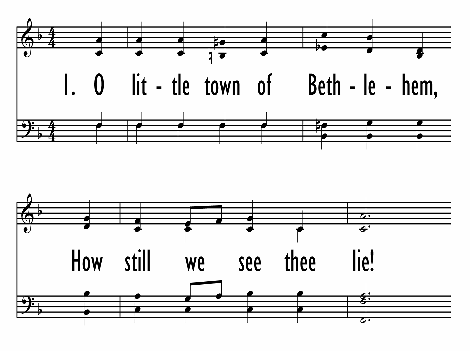- |
User Links
O Little Town of Bethlehem

O little town of Bethlehem
Author: Phillips Brooks (1868)Tune: ST. LOUIS (Redner)
Published in 851 hymnals
Printable scores: PDF, MusicXMLPlayable presentation: Lyrics only, lyrics + musicAudio files: MIDI, Recording
Representative Text
1 O little town of Bethlehem,
how still we see thee lie!
Above thy deep and dreamless sleep
the silent stars go by.
Yet in thy dark streets shineth
the everlasting light;
the hopes and fears of all the years
are met in thee tonight.
2 For Christ is born of Mary;
and, gathered all above,
while mortals sleep, the angels keep
their watch of wond'ring love.
O morning stars, together
proclaim the holy birth,
and praises sing to God the King,
and peace to men on earth.
3 How silently, how silently,
the wondrous gift is giv'n!
So God imparts to human hearts
the blessings of His heav'n.
No ear may hear His coming,
but in this world of sin,
where meek souls will receive Him still,
the dear Christ enters in.
4 O holy Child of Bethlehem,
descend to us, we pray;
cast out our sin and enter in;
be born in us today.
We hear the Christmas angels,
the great glad tidings tell;
O come to us, abide with us,
our Lord Emmanuel!
Source: Psalms and Hymns to the Living God #232
Author: Phillips Brooks
 Brooks, Phillips, D.D., was born at Boston, Dec. 13, 1835, graduated at Harvard College 1855, and was ordained in 1859. Successively Rector of the Church of the Advent, Philadelphia, and Trinity Church, Boston, he became Bishop of Mass. in 1891, and died at Boston in Jan., 1893. His Carol, "O little town of Bethlehem," was written for his Sunday School in 1868, the author having spent Christmas, 1866, at Bethlehem. His hymn, "God hath sent His angels to the earth again," is dated 1877.
--John Julian, Dictionary of Hymnology, New Supplement (1907)
Go to person page >
Brooks, Phillips, D.D., was born at Boston, Dec. 13, 1835, graduated at Harvard College 1855, and was ordained in 1859. Successively Rector of the Church of the Advent, Philadelphia, and Trinity Church, Boston, he became Bishop of Mass. in 1891, and died at Boston in Jan., 1893. His Carol, "O little town of Bethlehem," was written for his Sunday School in 1868, the author having spent Christmas, 1866, at Bethlehem. His hymn, "God hath sent His angels to the earth again," is dated 1877.
--John Julian, Dictionary of Hymnology, New Supplement (1907)
Go to person page >Text Information
Related Texts
| First Line: | O little town of Bethlehem |
| Title: | O Little Town of Bethlehem |
| Author: | Phillips Brooks (1868) |
| Meter: | 8.6.8.6 D |
| Language: | English |
| Notes: | German translation: See "O Bethlehem du kleine Stadt" by Helmut Barbe; Polish translation: See "Mieścino mala, Betlejem"> by Karol Hławiczka; Spanish translation: "Pequeño pueblo de Belén" by B. B. G.; See also "Oh pueblecito de Belén" by Thomas M. Westrup |
| Copyright: | Public Domain |
English
- A Book of Song and Service: for Sunday school and home #161
- A Calendar of Hymns #d40
- A Hymnal and Service Book for Sunday Schools, Day Schools, Guilds, Brotherhoods, etc. #184
- A Hymnal for Friends #158
- A Hymnal for Joyous Youth: An all-purpose hymnal for church, young peoples' services and Sunday schools #58
- A Junior's Praise #90
- A Manual of Worship: for the chapel of Girard College #268
- A Messenger for Jesus #d217
- A School Service Book #d116
- A Service Hymn Book #d106 10 shown out of 666
French Creole
Hebrew
Spanish
Welsh
Yiddish
Tune
ST. LOUIS (Redner)FOREST GREEN
FOREST GREEN is an English folk tune associated with the ballad "The Ploughboy's Dream." Ralph Vaughan Williams (PHH 316) turned FOREST GREEN into a hymn tune for The English Hymnal (1906), using it as a setting for "O Little Town of Bethlehem." Shaped in rounded bar form (AABA), FOREST GREEN has th…
For Leaders
Text:
In 1865, Phillips Brooks spent some time in Israel, and was in Bethlehem for Christmas. He rode on horseback through the fields around Bethlehem, and attended the Church of the Nativity on Christmas Eve. At that time, Brooks was rector of Holy Trinity Episcopal Church in Philadelphia. This hymn was probably inspired by this journey, but Brooks did not complete the hymn until 1868. That year, he commissioned a tune for it from his church organist so that it could be sung at the Sunday school service at his church for Christmas on December 27, 1868. It was originally written in five stanzas, but the fourth is usually omitted.
The hymn focuses on the relative silence of the birth of Christ – Bethlehem was just a little town, and only a few people paid attention to the event. The heraldic chorus of angels is minimized in the lines
“While mortals sleep, the angels keep Their watch of wondering love.”
The final stanza is a prayer that Christ would come and transform our lives.
Tune:
There are two tunes in common use with this text, and some hymnals include both. ST. LOUIS was commissioned by Brooks for the text in 1868 from the organist for Holy Trinity Episcopal Church, Lewis Redner. Redner delayed composing the tune until the night before it was to be sung for the first time, on December 27, 1868. He later wrote, “Neither Mr. Brooks nor I ever thought the carol or the music to it would live beyond that Christmas of 1868.” However, this tune and text pairing has lasted over one hundred forty years, and is one of the best-loved American Christmas hymns. Though the origin of the name of the tune is unclear, it was probably named after the composer by the publisher of The Church Porch of 1874, where this hymn was first published (with “Lewis” altered to “Louis”).
The other tune, FOREST GREEN is an English folk tune transcribed and arranged by Ralph Vaughan Williams in 1903. It first appeared in the English Hymnal in 1906 with this text. It was originally named “The Ploughboy’s Dream,” but Vaughan Williams named it after the village of Forest Green in Surrey, where he first heard it. This tune is more common in the UK.
When/Why/How:
This hymn is suitable for the Advent and Christmas seasons. It was originally written for children, but is used by Christians of all ages. The peaceful mood of the tune ST. LOUIS may be used to introduce or conclude a time of silent prayer. “O Little Town of Bethlehem” is an arrangement for choir and piano accompaniment with varying choral textures. “Christmas Carol Fest III” contains a handbell arrangement that can be used as an instrumental piece or to accompany singing. “O Come to the Manger” combines this hymn set to FOREST GREEN with the German children's carol, “O Come, Little Children,” employing men's voices and a children's choir with piano and flute accompaniment. Either tune may be used in a festive arrangement, such as “Hymn Introductions and Descants for Trumpet and Organ – Set 3,” which contains a setting of FOREST GREEN.
Tiffany Shomsky, Hymnary.org
Timeline
Arrangements
Media
The United Methodist Hymnal #230
- MIDI file from Baptist Hymnal 1991 #86
- MIDI file from Baptist Hymnal 1991 #86
- Audio recording from Baptist Hymnal 2008 #196
- MIDI file from The Cyber Hymnal #5100
- Audio recording from Evangelical Lutheran Worship #279
- Audio recording from Glory to God: the Presbyterian Hymnal #121
- MIDI file from Hymns and Carols #3
- MIDI file from Hallowed Hymns, New and Old: for use in prayer and praise meetings, evangelistic services, sunday schools, young people's societies and all other departments of church work #97
- Audio recording from Lift Up Your Hearts: psalms, hymns, and spiritual songs #88
- Audio recording from Lift Up Your Hearts: psalms, hymns, and spiritual songs #88
- Audio recording from Lift Up Your Hearts: psalms, hymns, and spiritual songs #88
- Audio recording from Small Church Music #251
- Audio recording from Small Church Music #251
- Audio recording from Small Church Music #251
- Audio recording from Trinity Hymnal (Rev. ed.) #201
- MIDI file from Timeless Truths #861
- Audio recording from The Worshiping Church #155
- MIDI file from The United Methodist Hymnal #230
- Audio recording from The United Methodist Hymnal #230
- Audio recording from The United Methodist Hymnal #230b
- Audio recording from Worship and Rejoice #180
- MIDI file from Worship and Rejoice #180
- Audio recording from Worship (4th ed.) #435


 My Starred Hymns
My Starred Hymns







